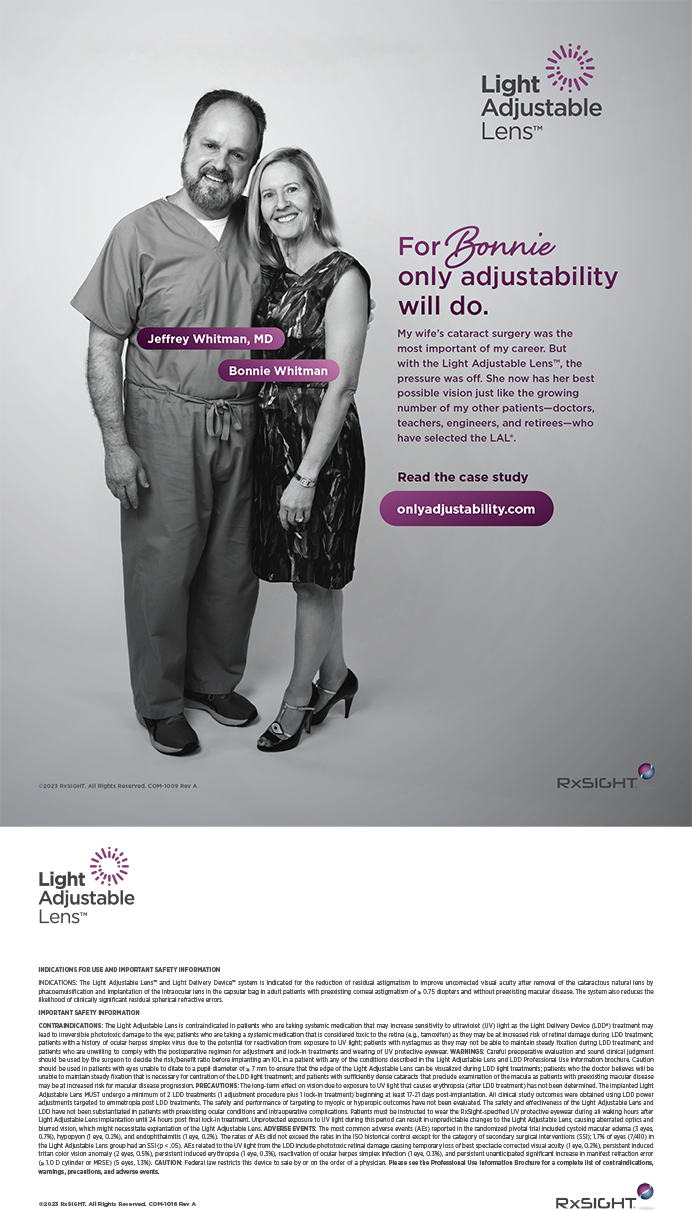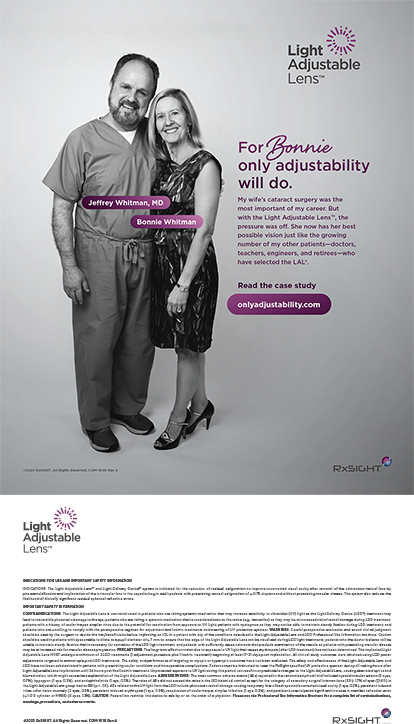CASE PRESENTATION
A 34-year-old black male underwent bilateral LASIK in February 2000 for refractions of -7.00 3.00 X100 = 20/20 OD and -7.00 3.25 X85 = 20/20 OS. He had successfully worn soft toric contact lenses for 15 years and had no pertinent medical or ocular history.
His preoperative pachymetry measured by ultrasound was 535 µm OD and 529 µm OS. His scotopic pupil size was 6 mm OU. The surgeon created a 137-µm LASIK flap OD and a 146-µm LASIK flap OS with an 8.5-mm ring and a 180-µm depth plate on a Hansatome microkeratome (Bausch & Lomb, Rochester, NY). Not adjusted with a nomogram, the depth of the ablation for this patient's prescription using the Visx Star S2 laser (Advanced Medical Optics, Inc., Santa Ana, CA) was 59 µm OD and 58 µm OS. The average keratometric values were 46.00 D OU. Figure 1A shows the preoperative topography.
On the first postoperative day, the patient's UCVA was 20/20 OU. Nine months later, his UCVA had improved to 20/15 OU (Figure 1B). At 2 years, his UCVA was 20/25 OD, improving to 20/20 with a refraction of -0.75 1.75 X10, and 20/40 OS, improving to 20/20 with a refraction of -2.00 2.00 X20 (Figure 1C). Six years postoperatively, his UCVA was 20/25 OD, improving to 20/20 with a refraction of -1.75 2.75 X10, and 20/50 OS, improving to 20/20 with a refraction of -3.25 3.75 X10 (Figure 1D).
At this point, the patient was highly motivated to improve the vision in his left eye. How would you proceed?
COLMAN R. KRAFF, MD
The incidence of iatrogenic ectasia appears to be on the rise in the postoperative LASIK population. This patient's preoperative clinical information seems to be relatively normal, except for a mild amount of orthogonal changes on the topography of his left eye. The topographies are shown in axial view. It is also important to look at elevation maps to check for any significant asymmetry. Doing so might have alerted the surgeon to something abnormal in this case. Often, patients with relatively normal axial maps will demonstrate significant asymmetry on elevation maps. I therefore routinely examine these maps as a part of all preoperative evaluations.
The patient's postoperative topographies demonstrate what appears to be bilateral ectasia. Of interest is the marked symmetry between his eyes. In my experience, post-LASIK ectasia tends to develop somewhat asymmetrically.
Postoperative ectasia is a severe complication that progresses in the majority of cases and causes patients to lose BSCVA. It is often difficult to fit these individuals with contact lenses, and they usually require a corneal transplant for visual rehabilitation. More recently, some patients have demonstrated a positive response to UV light cross-linking of the cornea with riboflavin.1 This procedure probably works by hardening the corneal collagen. It is relatively easy to perform, and early data suggest that the majority of corneas tend to stabilize.1
The patient in this case should be informed of the probable clinical progression of his condition and of the options for treatment: contact lenses; IOP-lowering medications; and UV-riboflavin corneal cross-linking.
LOUIS E. PROBST, MD
This patient is clearly developing ectasia after LASIK. The initial postoperative results were good up until the 9-month follow-up visit. Sometime after that but before the 2-year follow-up visit, the patient started to develop some refractive astigmatism bilaterally and inferior steepening on the topographies. He now has 2.75 D and 3.75 D of astigmatism in his right and left eyes, respectively, with an ectatic pattern on topography. Why?
The preoperative corneal thickness was sufficient in both eyes, and the LASIK flaps were not excessively thick. The ablation depths seem to be suspiciously low for the correction, but there should still be more than 250 µm in the residual stromal bed. The only area of concern in retrospect is the topography of the patient's left eye, which seems to show a slightly skewed pattern. An evaluation with the Orbscan topographer (Bausch & Lomb) might have shown abnormalities of the posterior cornea preoperatively.
The most important step in this patient's care is to "kill him with kindness." The statute of limitations for medical liability may not have expired in some states. This patient should not undergo further laser surgery, which could exacerbate the ectasia. I would suggest placing a contact lens to improve his vision. My colleagues at TLC The Laser Eye Centers have found the SynergEyes Hybrid Contact Lens (SynergEyes, Inc., Carlsbad, CA) to be effective for situations such as this one.
A trial of an IOP-lowering agent may reduce the degree of ectasia. Some surgeons have also had success with the placement of Intacs (Addition Technology, Inc., Des Plaines, IL) and the performance of conductive keratoplasty to improve the UCVA of patients like this one and to reduce their astigmatism from ectasia. I have not personally used this technique, however. In the future, cross-linking of the corneal collagen with riboflavin and UV light may stabilize the patient's ectasia.
THOMAS TOOMA, MD
The patient's 6-year postoperative topography is consistent with post-LASIK ectasia in both of his eyes. Ophthalmologists' understanding of the risk factors for this complication has changed over the years. In the past, we have all operated on eyes that had some of these risk factors but, fortunately, did not develop ectasia.
The only risk factor in this case is the preoperative topography, which shows nonorthogonal (skewed) astigmatism to a greater degree in the patient's left than right eye. It is likely that careful keratometry would have shown splitting of the mires and that dilated retinoscopy would have revealed scissoring of the retinoscopic reflex. Hindsight, however, is always 20/20.
It is important to note that some eyes develop ectasia without surgery. Moreover, the thickness of the residual stromal bed is not the entire story. Eyes can have risk factors but not develop ectasia. Neither, however, is there a safe residual thickness that will avert ectasia. There is actually no way to prevent this complication from occurring, but carefully assessing intraoperative pachymetry and not operating on eyes with abnormal topography will decrease its incidence. Finally, the biomechanics of corneas are most likely individual. I believe that each eye has a unique minimal thickness of the residual stromal bed that resists ectasia.
Although the central thickness of the LASIK flap created in this case was not greater than predicted, the thickness of the peripheral flap is not known. Because a greater number of fibrils are cut with a meniscus-shaped flap formed with a mechanical microkeratome, the cornea is weakened more than when flaps are created with the IntraLase FS laser (Advanced Medical Optics, Inc.) or during PRK.
This patient should not undergo a LASIK enhancement. Most important is to slow or stop the progression of ectasia. I would recommend prescribing IOP-lowering drugs in conjunction with the placement of Intacs and/or performing cross-linking of the corneal collagen with riboflavin and UV light. Other treatment options include spectacles, a soft toric contact lens, or a rigid gas-permeable contact lens.
BRIAN R. WILL, MD
The patient is clearly developing bilateral corneal ectasia that is worse in his left than right eye. This case challenges two dogmas of refractive surgery. Refractive surgeons generally believe that post-LASIK ectasia is unlikely if the preoperative keratography is normal and the residual stromal bed is greater than 250 µm.
From a diagnostic perspective, it would be instructive to know more about the ocular history of this patient's family, to inquire about ocular allergies or chronic eye rubbing, and to critically examine this patient's preoperative refractions over the prior 15 years to see if there was an abnormal progression of myopic astigmatism. In addition, optical coherence tomography would help demonstrate the actual thickness of the flap and residual stromal bed in multiple cross-sections of the cornea compared with the single intraoperative ultrasound pachymetry measurement provided. Perhaps most disconcerting is the fact that the preoperative Placido disk topography appears normal bilaterally, although the patient's left eye does exhibit a small amount of asymmetry to the astigmatism.
Assuming that the patient's family history is unremarkable, he does not rub his eyes, his preoperative refractions were truly stable, and the flap does not demonstrate excessive thickness peripherally, this case appears to illustrate the unreliable nature of using Placido disk videokeratography for preoperative screening as a clinical benchmark for determining a person's candidacy for LASIK surgery. After using Scheimpflug camera-based Pentacam technology (Oculus, Inc., Lynnwood, WA) combined with Optical Coherence Tomography (Visante, Carl Zeiss Meditec, Dublin, CA) for preoperative screening for the past several years, I am increasingly convinced that Placido disk keratography and its associated indices do not accurately reflect the actual state of all patients' corneal health. In addition, it is currently unclear what role, if any, individual variations in corneal plasticity and elasticity play in affecting tissue mechanical stability over the long term. Perhaps preoperative efforts to perform dynamic testing of corneal rigidity preoperatively could help to predict how a specific cornea might respond to thinning procedures. Clearly, an understanding of those factors that contribute to the structural integrity and shape of the cornea and deriving metrics to better predict long-term corneal shape appear to require the use of a more complex algorithm than can be provided by Placido-based keratography alone.
The appropriate clinical management of this patient is difficult at best. Certainly, no further laser refractive surgery should be performed. Fortunately, the eye remains correctable to 20/20 on manifest refraction, although the quality of vision is likely compromised. Fitting the patient with a soft toric contact lens would be a reasonable first step. The use of alternative soft lenses designed for keratoconus or reverse geometry gas-permeable lenses might be beneficial, with gas-permeable lenses being the best choice with respect to optical clarity and the added potential of acting to mold the cornea and reduce the progression to more ectasia.
Intacs are an option, but I generally do not suggest these segments unless a patient has lost BCVA and contact lenses are not useful. The merit of collagen cross-linking using riboflavin has not as yet been demonstrated in large clinical trials; much of the data remain anecdotal or in small series with short follow-up. One might consider cross-linking, but its efficacy is not well established. Emerging techniques using a femtosecond laser may provide new alternatives for deep anterior lamellar transplantation that could minimize the negative refractive impact of lamellar corneal grafting.
Cross-linking the cornea with UV light and riboflavin is not currently approved in the US.
Section editor Karl G. Stonecipher, MD, is Director of Refractive Surgery at TLC in Greensboro, North Carolina. Parag A. Majmudar, MD, is Associate Professor, Cornea Service, Rush University Medical Center, Chicago Cornea Consultants, Ltd. Stephen Coleman, MD, is Director of Coleman Vision in Albuquerque, New Mexico. They may be reached at (505) 821-8880; stephen@colemanvision.com.
Colman R. Kraff, MD, is Director of Refractive Surgery at the Kraff Eye Institute in Chicago. He acknowledged no financial interest in the products or companies mentioned herein. Dr. Kraff may be reached at (312) 444-1111; ckraff@kraffeye.com.
Louis E. Probst, MD, is Medical Director of TLC The Laser Eye Centers in Chicago, Madison, and Greenville, Illinois. He is a consultant to Advanced Medical Optics, Inc., and TLCVision. Dr. Probst may be reached at (708) 562-2020.
Thomas Tooma, MD, is Medical Director of TLC Vision Inc. in Newport Beach, California. He acknowledged no financial interest in the products or companies mentioned herein. Dr. Tooma may be reached at (949) 854-7400; tom.tooma@tlcvision.com.
Brian R. Will, MD, is Adjunct Clinical Professor of Ophthalmology at Loma Linda University Medical Center in California and is Medical Director of Will Vision and Laser Centers in Portland, Oregon. He acknowledged no financial interest in the products or companies mentioned herein. Dr. Will may be reached at (360) 885-1327; drwill@willvision.com.


